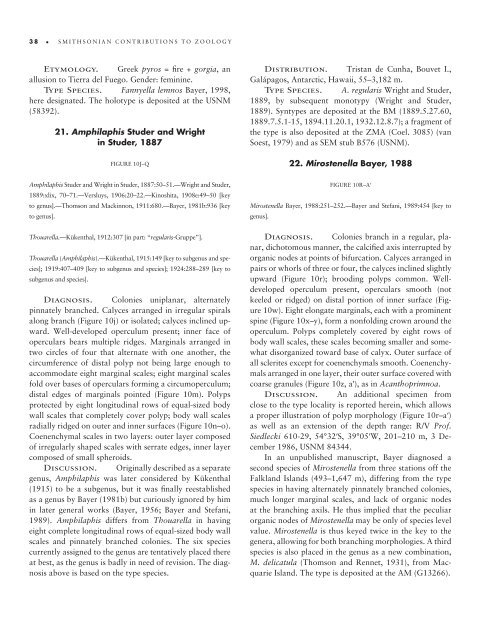A Generic Revision and Phylogenetic Analysis of the Primnoidae
A Generic Revision and Phylogenetic Analysis of the Primnoidae
A Generic Revision and Phylogenetic Analysis of the Primnoidae
Create successful ePaper yourself
Turn your PDF publications into a flip-book with our unique Google optimized e-Paper software.
38 SMITHSONIAN CONTRIBUTIONS TO ZOOLOGY<br />
Etymology. Greek pyros = fi re + gorgia, an<br />
allusion to Tierra del Fuego. Gender: feminine.<br />
Type Species. Fannyella lemnos Bayer, 1998,<br />
here designated. The holotype is deposited at <strong>the</strong> USNM<br />
(58392).<br />
21. Amphilaphis Studer <strong>and</strong> Wright<br />
in Studer, 1887<br />
FIGURE 10J–Q<br />
Amphilaphis Studer <strong>and</strong> Wright in Studer, 1887:50–51.—Wright <strong>and</strong> Studer,<br />
1889:xlix, 70–71.—Versluys, 1906:20–22.—Kinoshita, 1908e:49–50 [key<br />
to genus].—Thomson <strong>and</strong> Mackinnon, 1911:680.—Bayer, 1981b:936 [key<br />
to genus].<br />
Thouarella.—Kükenthal, 1912:307 [in part: “regularis-Gruppe”].<br />
Thouarella (Amphilaphis).—Kükenthal, 1915:149 [key to subgenus <strong>and</strong> species];<br />
1919:407–409 [key to subgenus <strong>and</strong> species]; 1924:288–289 [key to<br />
subgenus <strong>and</strong> species].<br />
Diagnosis. Colonies uniplanar, alternately<br />
pinnately branched. Calyces arranged in irregular spirals<br />
along branch (Figure 10j) or isolated; calyces inclined upward.<br />
Well-developed operculum present; inner face <strong>of</strong><br />
operculars bears multiple ridges. Marginals arranged in<br />
two circles <strong>of</strong> four that alternate with one ano<strong>the</strong>r, <strong>the</strong><br />
circumference <strong>of</strong> distal polyp not being large enough to<br />
accommodate eight marginal scales; eight marginal scales<br />
fold over bases <strong>of</strong> operculars forming a circumoperculum;<br />
distal edges <strong>of</strong> marginals pointed (Figure 10m). Polyps<br />
protected by eight longitudinal rows <strong>of</strong> equal-sized body<br />
wall scales that completely cover polyp; body wall scales<br />
radially ridged on outer <strong>and</strong> inner surfaces (Figure 10n–o).<br />
Coenenchymal scales in two layers: outer layer composed<br />
<strong>of</strong> irregularly shaped scales with serrate edges, inner layer<br />
composed <strong>of</strong> small spheroids.<br />
Discussion. Originally described as a separate<br />
genus, Amphilaphis was later considered by Kükenthal<br />
(1915) to be a subgenus, but it was fi nally reestablished<br />
as a genus by Bayer (1981b) but curiously ignored by him<br />
in later general works (Bayer, 1956; Bayer <strong>and</strong> Stefani,<br />
1989). Amphilaphis differs from Thouarella in having<br />
eight complete longitudinal rows <strong>of</strong> equal-sized body wall<br />
scales <strong>and</strong> pinnately branched colonies. The six species<br />
currently assigned to <strong>the</strong> genus are tentatively placed <strong>the</strong>re<br />
at best, as <strong>the</strong> genus is badly in need <strong>of</strong> revision. The diagnosis<br />
above is based on <strong>the</strong> type species.<br />
Distribution. Tristan de Cunha, Bouvet I.,<br />
Galápagos, Antarctic, Hawaii, 55–3,182 m.<br />
Type Species. A. regularis Wright <strong>and</strong> Studer,<br />
1889, by subsequent monotypy (Wright <strong>and</strong> Studer,<br />
1889). Syntypes are deposited at <strong>the</strong> BM (1889.5.27.60,<br />
1889.7.5.1-15, 1894.11.20.1, 1932.12.8.7); a fragment <strong>of</strong><br />
<strong>the</strong> type is also deposited at <strong>the</strong> ZMA (Coel. 3085) (van<br />
Soest, 1979) <strong>and</strong> as SEM stub B576 (USNM).<br />
22. Mirostenella Bayer, 1988<br />
FIGURE 10R–A′<br />
Mirostenella Bayer, 1988:251–252.—Bayer <strong>and</strong> Stefani, 1989:454 [key to<br />
genus].<br />
Diagnosis. Colonies branch in a regular, planar,<br />
dichotomous manner, <strong>the</strong> calcifi ed axis interrupted by<br />
organic nodes at points <strong>of</strong> bifurcation. Calyces arranged in<br />
pairs or whorls <strong>of</strong> three or four, <strong>the</strong> calyces inclined slightly<br />
upward (Figure 10r); brooding polyps common. Welldeveloped<br />
operculum present, operculars smooth (not<br />
keeled or ridged) on distal portion <strong>of</strong> inner surface (Figure<br />
10w). Eight elongate marginals, each with a prominent<br />
spine (Figure 10x–y), form a nonfolding crown around <strong>the</strong><br />
operculum. Polyps completely covered by eight rows <strong>of</strong><br />
body wall scales, <strong>the</strong>se scales becoming smaller <strong>and</strong> somewhat<br />
disorganized toward base <strong>of</strong> calyx. Outer surface <strong>of</strong><br />
all sclerites except for coenenchymals smooth. Coenenchymals<br />
arranged in one layer, <strong>the</strong>ir outer surface covered with<br />
coarse granules (Figure 10z, a′), as in Acanthoprimnoa.<br />
Discussion. An additional specimen from<br />
close to <strong>the</strong> type locality is reported herein, which allows<br />
a proper illustration <strong>of</strong> polyp morphology (Figure 10r–a′)<br />
as well as an extension <strong>of</strong> <strong>the</strong> depth range: R/V Pr<strong>of</strong>.<br />
Siedlecki 610-29, 54°32′S, 39°05′W, 201–210 m, 3 December<br />
1986, USNM 84344.<br />
In an unpublished manuscript, Bayer diagnosed a<br />
second species <strong>of</strong> Mirostenella from three stations <strong>of</strong>f <strong>the</strong><br />
Falkl<strong>and</strong> Isl<strong>and</strong>s (493–1,647 m), differing from <strong>the</strong> type<br />
species in having alternately pinnately branched colonies,<br />
much longer marginal scales, <strong>and</strong> lack <strong>of</strong> organic nodes<br />
at <strong>the</strong> branching axils. He thus implied that <strong>the</strong> peculiar<br />
organic nodes <strong>of</strong> Mirostenella may be only <strong>of</strong> species level<br />
value. Mirostenella is thus keyed twice in <strong>the</strong> key to <strong>the</strong><br />
genera, allowing for both branching morphologies. A third<br />
species is also placed in <strong>the</strong> genus as a new combination,<br />
M. delicatula (Thomson <strong>and</strong> Rennet, 1931), from Macquarie<br />
Isl<strong>and</strong>. The type is deposited at <strong>the</strong> AM (G13266).

















